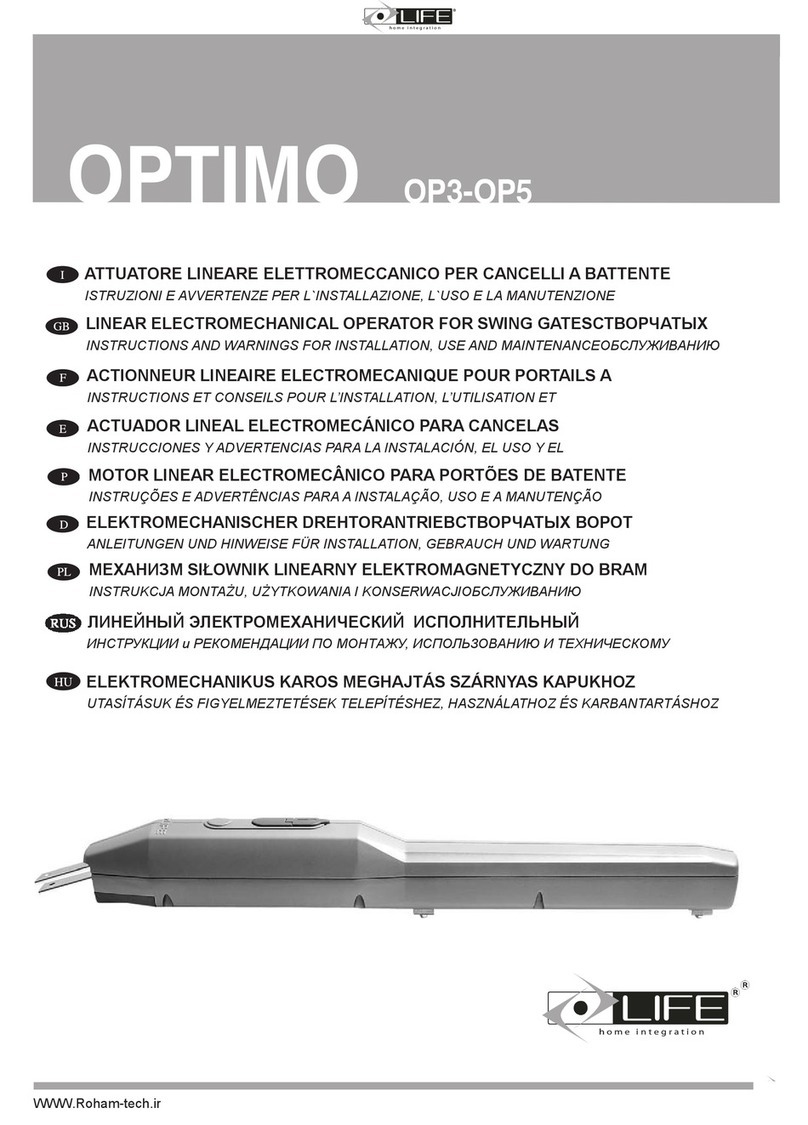
8
GBI F
INFORMAZIONI GENERALI
•La riproduzione di questo manuale
istruzioni è vietata senza la preventiva
autorizzazione scritta e successiva
verifica di LIFE home integration. La
traduzione in altra lingua, anche parziale,
è vietata senza la preventiva
autorizzazione scritta e successiva
verifica di LIFE home integration. Tutti i
diritti sul presente documento sono
riservati.
• LIFE home integration non risponde dei
danni o dei malfunzionamenti causati da
un’errata installazione o da uso improprio
dei prodotti; s’invita quindi ad una attenta
lettura del presente manuale.
• LIFE home integration non risponde dei
danni o dei malfunzionamenti causati
dall’utilizzo dell’automazione con
dispositivi d’altri produttori; questo
comporta anche il decadimento della
garanzia.
• LIFE home integration non risponde dei
danni o delle lesioni causati
dall’inosservanza delle informazioni
sull’installazione, messa in servizio,
manutenzione e uso riportate in questo
manuale, nonché dal mancato rispetto
delle prescrizioni di sicurezza riportate nel
cap. PRESCRIZIONI E AVVERTENZE DI
SICUREZZA.
• LIFE home integration, allo scopo di
migliorare i propri prodotti, si riserva il
diritto di modificarli in qualsiasi momento
e senza preavviso. Questo documento
rispecchia lo stato dell’automazione alla
quale è allegato al momento della sua
commercializzazione.
DATI DEL COSTRUTTORE
LIFE home integration è il costruttore
dell’automazione ARMOR (di seguito
chiamato costruttore) nonché il titolare di tutti
i diritti su questa documentazione. I dati del
costruttore, come richiesto anche dalla
direttiva Macchine 98/37/CE, sono i seguenti:
•Costruttore: LIFE home integration S.r.l.
•Indirizzo: Via I Maggio, 37 – 31043
FONTANELLE (TV) Italia
•Telefono: + 39 0422 809 254
•Telefax: + 39 0422 809 250
•http: www.homelife.it
Sulla targhetta d’identificazione sono riportati
i dati del costruttore dell’automazione, il tipo
e data di produzione (mese/anno).
Per informazioni tecniche e/o commerciali,
richieste d’invio di personale tecnico, richiesta
di parti di ricambio, il cliente può contattare il
costruttore o il rappresentante di zona presso
il quale è stato acquistato il prodotto.
INFORMATIONS
GENERALES
•Il est interdit de reproduire ce mode
d’emploi sans l’approbation et
l’autorisation écrites et sans la vérification
de LIFE home intégration. Il est interdit
de traduire ce mode d’emploi dans une
autre langue, même partiellement, sans
l’approbation et l’autorisation de LIFE
home intégration. Tous les droits du
présent document sont réservés.
• LIFE home intégration décline toute
responsabilité en cas de dommages ou
de fonctionnements défectueux dus à une
mauvaise installation ou à une utilisation
incorrecte des produits. Lire attentivement
ce mode d’emploi.
• LIFE home intégration décline toute
responsabilité en cas de dommages ou
de fonctionnements défectueux dus à
l’utilisation du système automatisé avec
les dispositifs d’autres producteurs. Cela
entraîne l’annulation de la garantie.
• LIFE home intégration décline toute
responsabilité en cas de dommages ou
de lésions dus à la non observation des
informations relatives à l’installation, à la
mise en service, à l’entretien et à
l’utilisation spécifiées dans ce mode
d’emploi ou au non respect des
prescriptions de sécurité indiquées dans
le chapitre PRESCRIPTIONS ET
CONSIGNES DE SECURITE.
•Dans un souci d’amélioration de ses
produits, LIFE home intégration, se
réserve le droit de les modifier à tout
moment sans préavis. Ce document
représente l’état des produits automatisés
à leur commercialisation.
DONNEES RELATIVES AU
FABRICANT
LIFE home intégration est le fabricant du
système automatisé ARMOR (désigné par la
suite sous le nom « Fabricant ») et possède
tous les droits sur ce document.
Conformément à la directive sur les Machines
98/37/CE, les données du fabricant sont les
suivantes:
•Fabricant : LIFE home integration S.r.l.
•Adresse : Via I Maggio, 37 – 31043
FONTANELLE (TV) Italia
•Téléphone :+ 39 0422 809 254
•Télécopie : + 39 0422 809 250
•http : www.homelife.it
Les données relatives au fabricant du
système automatisé, au type et à la date de
production (mois / année) de l’automatisme
sont indiquées sur la fiche d’identification.
Pour d’autres informations techniques et / ou
commerciales ou d’envoi du personnel
technique ou de demande de pièces
détachées, le client peut contacter
directement le fabricant ou le réseau de vente
auprès duquel il a acheté le produit.
GENERAL INFORMATION
•It is strictly forbidden to copy or reproduce
this instruction manual without written
permission to do so and subsequent
verification by LIFE home integration.
Translation into other languages of all or
part of the manual is strictly forbidden
without previous written authorisation
from and subsequent verification by LIFE
home integration. All rights on this
document are reserved.
• LIFE home integration will not accept
responsibility for damage or malfunctions
caused by incorrect installation or
improper use of products and Users are
therefore recommended to read this
manual carefully.
• LIFE home integration will not accept
responsibility for damage or malfunctions
caused by the use of the automation
together with the devices of other
manufacturers; such action will render the
warranty void.
• LIFE home integration will not accept
responsibility for damage or injury caused
by non-compliance with the installation,
set up, maintenance and use indications
contained in this manual and the safety
instructions described in the SAFETY
INSTRUCTIONS AND WARNINGS
chapter.
•With the aim of improving its products,
LIFE home integration reserves the right
to bring about alterations to them at any
time, without giving prior notice. This
document conforms to the state of the
automation at which it is provided when
released for sale.
INFORMATION ON THE
MANUFACTURER
LIFE home integration is the manufacturer
of the ARMOR automation (and will
hereinafter be referred to as manufacturer)
and the owner of all rights concerning this
document. The Manufacturer’s information
required by Machinery Directive 98/37/EC is
as follows:
•Manufacturer:
LIFE home integration S.r.l.
•Address: Via I Maggio, 37 – 31043
FONTANELLE (TV) Italy
•Telephone: + 39 0422 809 254
•Fax: + 39 0422 809 250
•http: www.homelife.it
The identity plate bears information on the
Manufacturer of the operator and specifies the
type and date (month/year) of manufacture.
For further information on technical or
commercial issues and technician call-out and
spares requests, Clients may contact the
Manufacturer or area representative from
whom the product was purchased.






























